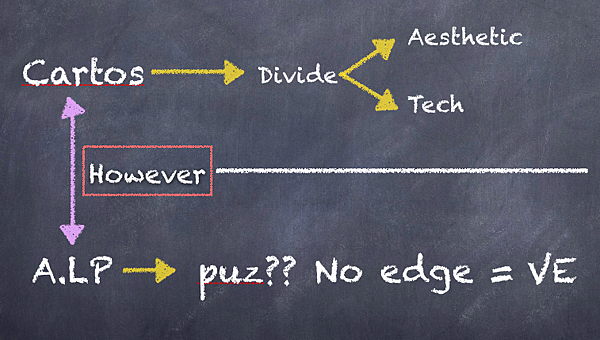A divide between aesthetic and technical considerations has played a crucial role in mapmaking and cartographic scholarship. Since nineteenth century cartographers, for instance, understood themselves as technicians who did not care about visual effects, while others saw themselves as landscape painters. That dichotomy structured the discipline of the history of cartography. Until the 1980s, in what Blakemore and Harley called “the Old is Beautiful Paradigm,” scholars largely focused on maps made before 1800, marveling at their beauty and sometimes regretting the decline of the pre-technical age. Early mapmaking was considered art while modern cartography was located within the realm of engineering utility. Alpers, however, has argued that this boundary would have puzzled mapmakers in the seventeenth century, because they considered themselves to be visual engineers.
1. According to the passage, Alpers would say that the assumptions underlying the “paradigm” were
A. inconsistent with the way some mapmakers prior to 1800 understand their own work
B. dependent on a seventeenth-century conception of mapmaking visual engineering
C. unconcerned with the difference between the aesthetic and technical questions of mapmaking
D. insensitive to divisions among cartographers working in the period after 1800
E. supported by the demonstrable technical superiority of mapmaking made after 1800
2. It can be inferred from the passage that, beginning in the 1980s, historians of cartography
A. placed greater emphasis on the beauty of maps made after 1800
B. expanded their range of study to include more material created after 1800
C. grew more sensitive to the way mapmakers prior to 1800 conceived of their work
D. came to see the visual details of maps as aesthetic objects rather than practical cartographic aids
E. reduced the attention they paid to the technical aspects of mapmaking
結構分析:
一開始先來看第一句話,出裡題目要先知道他們在討論啥麼,有了主幹出來才比較好分辨,首先看到第一句顯示A divide between aesthetic and technical哇一開始就給了一個分類了,divide俗稱『必ㄘㄟ』,所以老司機可能已經猜到本文章接下來要探討到底怎麼分了,沒錯,相信你的直覺,crucial role後面來了mapmaking and cartographic scholarship,兩個東西,那感覺應該就是要就這美學和技術去跟地圖製作和地圖的學問去強行速配,好的接下來繼續看有沒有做這方面的分類,就要看到第二句了。
第二句中Since nineteenth century cartographers, for instance,其實看到例如就可以不用看了,因為出現例如就表示他要對上面的觀點做出舉證,因此這觀點很明顯就是探討那個divide到底差在哪裡,因此我是覺得不用看下去了,邏輯方面還是朝著aesthetic VS. technical他們之間有所不同的角度去寫,當然如果不放心也是可以往下看拉understood themselves as technicians who did not care about visual effects, while others saw themselves as landscape painters.這裡就明確指定說他們到底哪裡不同了,他說道技術派的人不在乎視覺感受,然後相反的其他人,這裡其他人就是美學派拉,別猶豫了,他們覺得是一幅畫作,而且其實這裡真的不用看while後面的東西,應該while前面看完就要結束別再浪費時間了,因為while是一個具內轉折詞的邏輯字,GRE幾乎都把它都but用,用於句內邏輯相反,所以真的不建議考試一個單字一個單字的摳,好看到這裡文章結構已經非常清楚了,真的別再看第三句話了,接下來要找的東西是看有沒有轉折詞出現,像是however, yet, but, nevertheless這類的。
Alpers, however, has argued that this boundary would have puzzled mapmakers in the seventeenth century, because they considered themselves to be visual engineers.這裡出現了轉折詞了,爽啊~~而且剛好最後一句,來看看他要怎麼打槍aesthetic VS. technical,他說道boundary是puzzled,OK!他說界線不明顯,因為Alpers這位大大,應該是男生吧,A/ LP/ er(代表人~~一個有蛋蛋的人),認為是visual engineers這種工程師比較合理,我也不知道這是哪種職業,工業設計師??視覺系工程師,算了,記得是VE就好,好了讀了兩句多一點就可以把文章主幹抓住了,建議真的不要把文章看完,這樣會讓自己進入混沌狀態,進入微觀態,有機會變不回來

第一題:
題目問到Alpers對paradigm的看法如何,這個由結構圖已經可以說明了,A他覺得沒有界限,但是題目的paradigm出現however之前,表示他是用來支持divide的觀點的,所以二話不說,A所持的觀點就是反對分門別類,好的直接秒殺, 選(A)
補充:也可以從個選項的動詞來看,A. inconsistent ,B. dependent on,C. unconcerned ,D. insensitive ,E. supported ,這裡B和E是正向支持邏輯的所以算不理他了,(C)這個觀看可能猜不出來,要看一下整個選項,他說不關心兩者差異,這個就太扯了,文章都寫這麼多了還不關心,(D)冷感,對divisions感到冷感,這更好笑了,文章應是對於美學和技術的分壘,不是對作品的區別,所以能夠體現出however的也只有(A)選項。however除了不認同上述的觀點之外,還會加註哪裡不認同,選(A)
第二題:
推理題,這類題目就是除了找到主角之外,然後再加上條件,依照條件限制下來選這五個答案,這條件彷彿就是看到苦海中的明燈,所以現在要先來找明燈是誰,這裡給一個時間關係詞,beginning in the 1980s,回推原文,也只有這句話由提到1980,Until the 1980s, in what Blakemore and Harley called “the Old is Beautiful Paradigm,” scholars largely focused on maps made before 1800, marveling at their beauty and sometimes regretting the decline of the pre-technical age。然後這個Until很重要,他是時間的分水嶺,他之前『有』句子裡形容的事情,他之後『無』句子形容的事情,所以處理題目時『可以視為before』,而題目問到beginning表示1980之後,所以注意一下該句的主幹『並取反』,輕輕鬆鬆答案就出來了,as easy as making a free throw,但不包括歐肥歐尼爾。該主幹為Until the 1980s, in what Blakemore and Harley called “the Old is Beautiful Paradigm,” (這插入句請自動跳過)scholars largely focused on maps made before 1800, marveling at their beauty and sometimes regretting the decline of the pre-technical age,他們關注一些before1800的地圖,請注意後面開始是分詞構句的部分,他並不是最最最最重要的主幹,marveling讚嘆他們的美麗,感恩西父,讚嘆西父。然後還有覺得對於decline有點惋惜,分詞亂我主幹者~~~必殺之!!!!前面這是針對1980之前的態度,所以1980之後就變成前面的東西都取反就好了,也就是:關注一些before1800的地圖,變成『不完全』關注一些before1800的地圖,分析完會去找選項,(B)選項剛好『取反』的態度,選(B)
補充:conceived of:想出,想像,把它當作正向邏輯表示認同
以上個人筆記希望有幫助到大家,有誤再請指教!!



 留言列表
留言列表

 {{ article.title }}
{{ article.title }}
